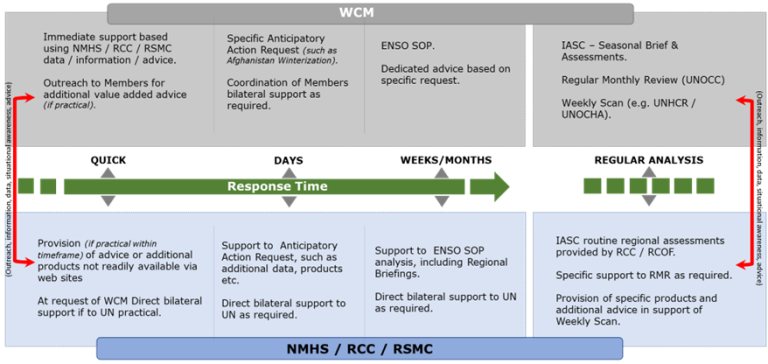WCM Background

WMO has been long calling for the creation of a sustainable capability to coordinate enhanced support to humanitarian agencies from the United Nations and other organizations in case of natural disasters. In 2019, during the 18th World Meteorological Congress, WMO Members endorsed the resolution 14 and tasked the Services Commission (SERCOM) to develop the WMO Coordination Mechanism (WCM), which the main objective is to enable access to authoritative weather, water and climate information and the provision of expert advice from WMO Members to the UN and other humanitarian agencies to advance Anticipatory Action and Crisis Support.
| WMO Resolution | Description |
|---|---|
| Resolution 14 (Cg-18) | Initial Concept for the WMO Coordination Mechanism to Support the Humanitarian Activities of the United Nations & Other Organizations |
| Resolution 3 (EC-75) | UN Global Early Warning/Adaptation Initiative |
| Resolution 14 (EC-76) | WMO Coordination Mechanism Implementation Plan |
In March 2023, the WCM Implementation Plan (IP) was adopted by the WMO Executive Council (EC-76). The IP described in more details how the WCM is planning to curate authoritative information, data and expert advice from WMO Members and Centres into products and services. These include but are not limited to commented infographics and briefings for UN and humanitarian agencies, and contributions to the Inter-Agency Standing Committee (IASC) i.e. IASC ENSO Analysis Cell, Monthly Risk and Hazard Scanning Assessment, Multi-Agency Drought Alert, and Multi Agency Drought Alert for Greater Horn of Africa.

Value in service delivery has been driven by the support and guidance of the WCM Expert Team, a co-design approach and a feedback loop to guarantee that the needs of the UN and humanitarian agencies are understood, products are designed accordingly, and new requirements incorporated.
As described in the WCM Implementation Plan, the core facility of the WCM is the Coordination and Briefing Team (CBT), which is responsible for the provision of curated authoritative information and advice. The CBT is a member-driven team placed under the overall management and coordination of WMO which seeks to provide routine and situation awareness hydromet-related information to the humanitarian community (see figure 2).

While the primary focus of the WCM Implementation Plan is the development and implementation of the Coordination and Briefing Team (CBT), parallel activities related to training and knowledge-sharing, formalization of linkages with other WMO initiatives and implementation of formal monitoring, reporting and governance mechanisms will also take place throughout the WCM implementation.
The 18th World Meteorological Congress Cg‑18 mandated the development of the concept of WCM to support UN and humanitarians. The contributions of WMO Members through WCM have started to have an impact on the UN Humanitarian Coordination Forum, the Inter-Agency Standing Committee (IASC) and other UN Organizations and Humanitarian Agencies. First prototypes have been also developed to provide expert advice to humanitarian agencies, such as the WCM Prototype at regional scale – SW Indian Ocean Info Graphic (Figure 3) and WCM Prototype at global scale -Global HydroMet Scan- UNHCR.

Following the approval of the IP in EC-76, the 77th Session of the WMO Executive Council (EC-77) on June 2023 has approved the development of the WCM Resource Mobilization Plan, which detailed the WCM resource requirements including a governance structure (boards), the Coordination and Briefing Team for service delivery, the WMO secretariat for management, and supporting initiatives, such as the pilot project Weather4UN by the Federal Office for Meteorology and Climatology MeteoSwiss.
